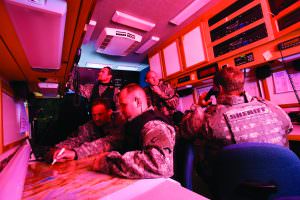Dialing Up Security

Smartphones can be an essential component of a mass notification system
Smartphones permeate our lives. In fact, 91 percent of adults keep their smartphones within arm’s reach, according to Morgan Stanley, and Daily Infographic reported that the average person looks at his or her phone approximately 110 times a day.
Consumers are clearly hooked on this multifaceted lifeline. In today’s mobile culture, the rise of these devices has changed the communications landscape, offering more options for security companies to utilize technology to streamline operations through access control, two-way communications and – most importantly – emergency management and incident response.
The safety and security capabilities that are available keep increasing. Parents can now track their children through their phones; Amber and severe weather alerts are automatic, and surveillance camera footage can be streamed on the devices of security personnel. About three-fourths of cell owners have used their phones to get help in an emergency, according to the Pew Research Center, and many people use Twitter or Facebook, as well as other social media platforms, to locate or check in with friends and relatives during a crisis.
Specific sectors of public security, such as access control manufacturers and incident response software developers, have shifted to a more digital world. This has led to more streamlined responses in dangerous situations.
Real-Life Incidents Warrant Action
In 2007, a Virginia Tech student opened fire at the university, killing 32 people and wounding 17 others before killing himself. Last year, 49 people were killed by a gunman at Pulse nightclub in Orlando, Fla. And in May of this year, Manchester Arena in the United Kingdom was the site of a bombing that took the lives of 22 people and injured 116 after an Ariana Grande concert.
Expansive, high-capacity environments like these can easily become targets. Sprawling campuses and event venues are also vulnerable to a variety of other threats, such as severe weather and other natural disasters, making it critical to have an emergency preparedness plan in place.
But with so many people, it can be difficult to thoroughly monitor activity and efficiently communicate to each and every individual in the event of an emergency. This is where mobile devices can become useful tools for incident response.
Real-Time Location Services and Incident Response
The use of cell phones for incident response and emergency management is based on real-time location system (RTLS) technology, which is used to automatically identify and track the location of objects or people in real time. This is usually done within a building or other enclosed area. It is like GPS, but for indoors. While GPS is able to track vehicles as they move across the globe, it is unable to track the hundreds – if not thousands – of devices that are often in a small space, such as an event venue or a busy airport facility. This is where RTLS becomes the best means by which to communicate location. RTLS technology has the ability to read wireless devices automatically and continuously, making it a better fit for security purposes.

Using smart devices that send a signal to a central monitoring platform through the facility’s Wi-Fi connection, security officials can know where people are located within a specific area and can alert them in the event of an emergency without having to use an application.
It is unlikely that security personnel could reach every person within a facility verbally, so a platform that uses an item almost every person already has can help facilitate a faster response.
RTLS technology is also well suited for supply chain management, healthcare, military and government, retail, recreation, and education. In terms of security, RTLS has a significant and emerging place in the market.
Emergency Preparedness Planning
 The use of RTLS technology must be coupled with a comprehensive emergency management plan. To start, organizations must first identify and implement best practices for incident response, including:
The use of RTLS technology must be coupled with a comprehensive emergency management plan. To start, organizations must first identify and implement best practices for incident response, including:
Establishing internal communications – Answering important questions, such as who will be responsible for sending messages and what technology will be used, is critically important.
- Involving external stakeholders – Establishing fluid partnerships between an organization and first responders before an incident occurs is vital. Determining who should be involved, how they should be notified and how information should be shared are among the factors that must be addressed.
- Using technology – Mass notification solutions allow organizations to send out both standardized and customized messages through a variety of methods. Determining the kind of technology that will be used, as well as establishing standard operating procedures when using the technology, will help augment emergency response.
- Clearly defining involvement – There needs to be a clearly defined chain of command within every organization that identifies who is responsible for communicating with each group of stakeholders, and how they are going to communicate with them. There should also be a backup plan in case of absences.
- Tailoring messaging – Because each and every event is different, strategies should be in place to respond accordingly. A bomb threat is much different than an active shooter incident or severe weather. Messages and their content need to reflect proper procedures.

While all of these best practices can be used together to formulate a comprehensive plan of action in the event of an emergency, the most important factor is to involve local law enforcement and fire department officials in any incident management planning. Not only do they need to understand what the specific emergency messaging and evacuation processes are for a particular business or institution, they also need to be familiarized with the ins and outs of the facilities themselves. This will likely include the locations of entrances and exits, surveillance cameras, and alarm triggers, as well as details of how lockdowns are implemented. All of this information can be combined to present a complete picture of a facility’s response plan before it is needed. Failing to keep first responders in the loop can cause confusion during an emergency.
Strengthening Collaboration with RTLS
The choice to implement a mass notification system is a large undertaking for security leaders, and it can be a major investment, which means ease of use, scalability, and flexibility must be considered.
Not only does RTLS technology work well in an emergency situation for communications between first responders and those experiencing the incident, but it can also be used on a routine basis.

For example, in a campus environment, administrators can communicate directly with faculty and students about an event or an upcoming closure. Retail locations can communicate promotions to customers on a regular basis, boosting marketing efforts and sales. Event Venues and stadiums can communicate weather delays or other key developments that affect start times. And these are just a few of the innovative ways that smartphones can be used to streamline and enhance operations.
The ongoing advancement and development of mass notification and communications systems continue to offer end users a wide range of options to improve their responses during emergencies. Being able to utilize existing location-based smartphone technology – integrated with access control, video surveillance, and alarm systems – improves an organization’s ability to protect people and assets, while enhancing response and investigation capabilities.

Jana Rankin (jrankin@vuteur.com) is the CEO of VuTeur (www.vuteur.com).
